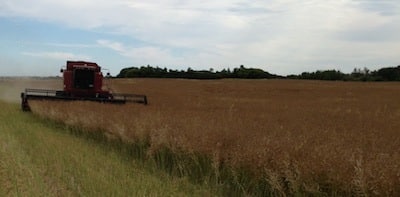Glyphosate is registered for pre-harvest perennial weed control in canola. Glyphosate is to be applied when the majority of seeds are yellow to brown in colour and seed moisture is less than 30%. Applications made even slightly before the 30% moisture stage (physiological maturity) greatly increase the risk of excessive glyphosate residue in the seed. Canola is very efficient at moving glyphosate or other systemic compounds into the grain prior to physiological maturity. Excessive pesticide residues in the grain can result in export problems.
Some growers who straight combine canola that is not a glyphosate tolerant variety will apply glyphosate to even out the crop for easier harvest. When using glyphosate in this fashion, make sure a majority of the field is mature for the reasons indicated above.
The rate of drydown with preharvest glyphosate is heavily dependent on environmental conditions, so weed control should still be the main goal. Glyphosate will not hasten crop maturity, but you know the crop and the weeds will be ready to harvest in about three weeks.
Reglone is a contact herbicide (only kills what it contacts) and is registered in canola to dry immature green material to facilitate harvest. Reglone does not hasten crop maturity. It shuts the plant down quickly and basically STOPS it from maturing, which can lock in high green seed levels if applied prematurely. The recommended timing for application on canola is when 80-90% of the seed has turned brown. The label indicates that it should be only applied to B. napus canola to facilitate dry down of lodged canola crops. Efficacy will be maximized with the highest water volumes feasible (minimum 91 up to 222 L per acre ground or 18 L per acre aerial).
Growers using Reglone on canola to be straight combined take note: Reglone can increase both pod shatter and pod drop if harvesting is delayed, so be prepared to combine as soon as green seed and seed moisture have reached suitable levels. A tip for Reglone use: Reglone is activated immediately in day light, so application in the evening will allow the herbicide to spread slightly from the droplet contact point before activation the next morning and result in more complete coverage on plant tissues.

